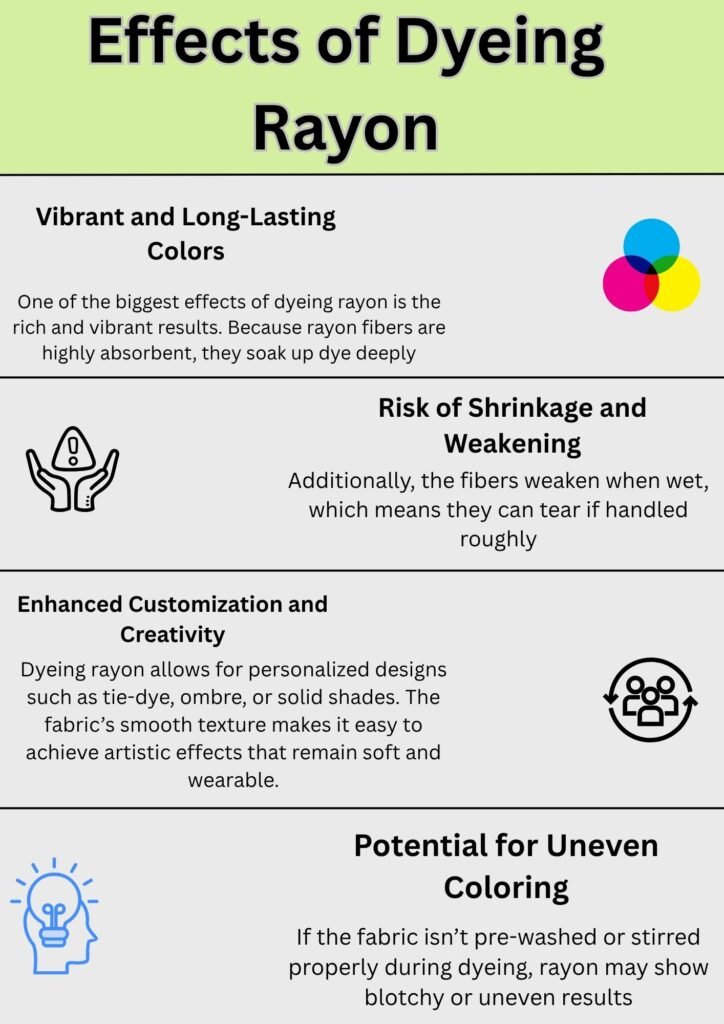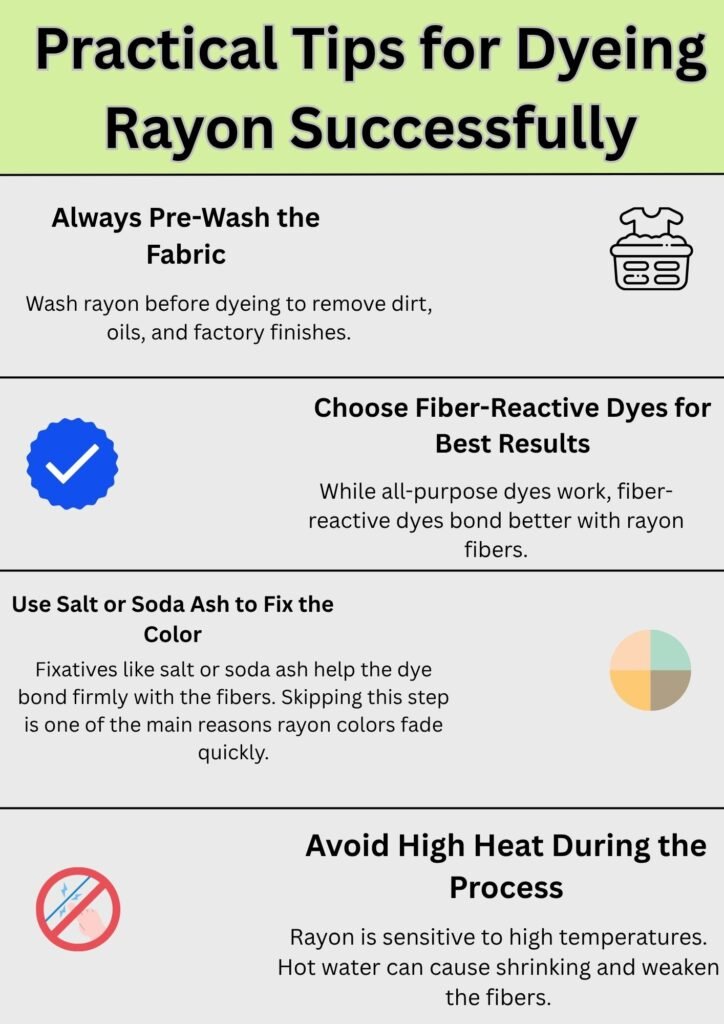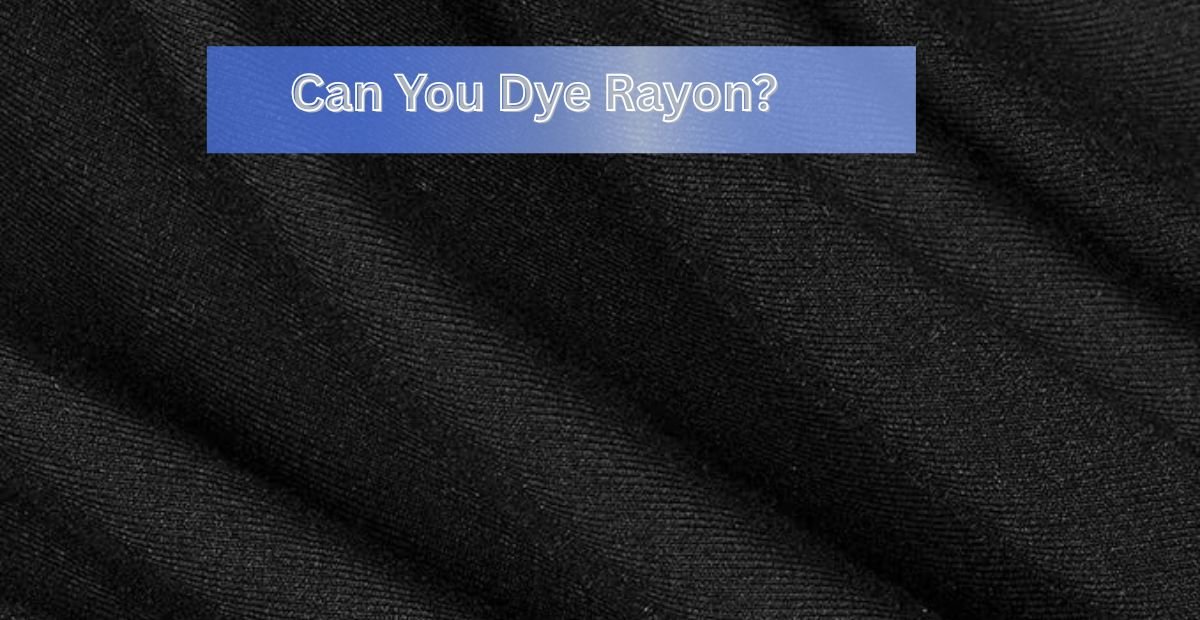Introduction
Rayon is a semi-synthetic fiber that is produced by the use of cellulose fibers of wood pulp. It has a natural absorbency and soft texture which makes it comparable to cotton. The question many people ask is, is it possible to dye rayon as they can cotton or polyester?
The answer to this is, yes, yes, you can dye rayon, though with a lot of preparation and the correct type of dye. Rayon takes on any dye well, unlike polyester, however it also tends to shrink or lose strength when not properly handled. This guide will discuss the most appropriate dyes, techniques as well as recommendations to get a long life and bright colors on rayon.
What is Rayon?
Rayon is a multifunctional fabric commonly referred to as artificial silk due to its feel and fall. It is made out of recycled cellulose fibers, and thus it is semi-synthetic, neither natural nor synthetic.can you dye rayon
Types of Rayon
- Viscose Rayon- This is the most prevalent form that is smooth and absorbent yet shrinks easily.
- Modal Rayon – This is a softer and more durable one, which is easier to dye uniformly.
- Lyocell (Tencel) – More environmentally responsible, durable and will not weaken easily during dyeing.
Properties Affecting Dyeing
Rayon is very absorbent and thus very good in dyeing. However, it also:
- Shrinks when exposed to heat.
- Old soft when wet, and to be handled carefully.
- Effloresces when there is no proper fixing of colors.
Knowing these properties will be useful to make sure that your dyeing project does not harm.
Can You Dye Rayon?
Yes, rayon can be dyed, and the effect is usually very bright due to the good uptake of color by the fibers. Nevertheless, it all depends on the kind of dye you apply and the fabric special finish.can you dye rayon
Rayon is more dyeable like cotton than polyester is. This is to say that fiber-reactive or natural dyes would be the most effective in this case. When the dye applied is of a low quality or when fixatives are omitted, then the color can fade rapidly.
However, while rayon dyes beautifully, it is also a delicate and temperamental fabric. Unlike cotton or linen, rayon weakens when wet, shrinks under high heat, and can become misshapen if handled roughly.can you dye rayon This means the process of dyeing rayon requires extra care and attention at every stage—choosing the right dye, controlling water temperature, stirring gently, and setting the color properly. If you skip these steps, you risk blotchy results, fading, or even damaging the fabric permanently.
Effects of Dyeing Rayon
Dyeing rayon brings both positive outcomes and potential challenges, depending on how carefully the process is done.can you dye rayon Understanding these effects helps you make better decisions and avoid surprises when working with rayon fabric.

Vibrant and Long-Lasting Colors
One of the biggest effects of dyeing rayon is the rich and vibrant results. Because rayon fibers are highly absorbent, they soak up dye deeply, creating strong, bold colors that often look brighter than on other fabrics like polyester.
Risk of Shrinkage and Weakening
Rayon can shrink when exposed to high heat during the dyeing process. Additionally, the fibers weaken when wet, which means they can tear if handled roughly.can you dye rayon This effect makes it important to use gentle methods and low heat.
Enhanced Customization and Creativity
Dyeing rayon allows for personalized designs such as tie-dye, ombre, or solid shades. The fabric’s smooth texture makes it easy to achieve artistic effects that remain soft and wearable. This effect is especially popular for fashion and crafts.
Potential for Uneven Coloring
If the fabric isn’t pre-washed or stirred properly during dyeing, rayon may show blotchy or uneven results. This effect can either ruin the project or create a unique, textured appearance depending on your preference.
Best Dyes for Rayon
It is important to select the dye. All dyes do not attach themselves to rayon fibers. Let’s compare the main types:
Fiber-Reactive Dyes
Rayon is the most suitable to make use of fiber-reactive dyes. They develop a good chemical attachment with cellulose fibers giving rich and vibrant colors.can you dye rayon Such dyes also deteriorate slower.
All-Purpose Dyes
Rayon can be used with all purpose dyes like Rit but the color may not be as bright and durable. They are less challenging to the novices but may not last as long once they had been washed a few times.
Natural Dyes
Rayon can be dyed in plant-based dyes, like indigo or turmeric. These give less harsh and more natural tones, but need mordants such as alum or vinegar to fix the color.
Pros and Cons:
- Fiber-reactive: Colorful, durable, however, needs soda ash or salt.
- All-purpose: Simple to operate, weakening.
- Natural dyes: Unique, environmentally friendly colors, but not as colorfast.
Dyeing Rayon (Wiki Guide)
And this is the stepwise way to get beautiful results:
Preparation
- Pre-washing of fabric before dyeing is used to remove finishes.
- Try a swatch in order to preview a color result.
Choosing the Right Dye
- Choose a dye that is fiber-reactive to produce bright colours. Polyester-specific dyes are not permitted- they will not bond with rayon.
Dyeing Process
- Dye It Place the dye in hot water according to instructions.
- Wet the rayon material in the dye bath.
- To avoid blotches, stir continuously.
Fixing the Color
- Depending on the dye, add salt, soda ash or vinegar.
- This will seal the color onto the fibres and make it not fade.
Rinsing & Aftercare
- Rinse under cold water till it comes clear.
- Wash individually in mild detergent.
- Air dry flattened to prevent stretching or shrinkage.
Common Mistakes to Avoid When Dyeing Rayon
Numerous dyeing works fail as a result of mistakes. These are some of the main pitfalls to be avoided:
- Wrong dye- Polyester dyes can not be used on rayon.
- Omitting pre-washing – The finishes of dirt and fabric prevent the uptake of dye.
- Excessive heat exposure- Rayon gets weak or shrinks when exposed to hot water or dryers.
- No fixatives -Colors will fade easily without salt or soda ash.
These errors can be avoided to achieve smooth, even and vibrant results.
Can You Tie-Dye Rayon?
Yes rayon is a wonderful tie-dye drug. Due to the absorbent fibers, tie-dye patterns are bright and bold.
Tips for Tie-Dye Rayon:
- Apply fiber-reactive dyes to bright colors.
- Store bands of rubber tautly to achieve definite designs.
- To preserve the fabric, do not let the fabric to get too hot.
Rayon tie-dye is used to produce loosely fitting, artistic-colored clothing.
Tying Techniques That Work Best on Rayon
Because rayon is soft and drapey, it can be harder to hold folds than cotton. Try these methods:
- Rubber Bands: Wrap tightly to prevent dye bleeding into areas meant to stay white.
- String or Twine: Works well for creating sharper, defined lines.can you dye rayon
- Folding Techniques: Accordion folds, spirals, or crumple effects give bold, artistic designs.
Can You Dye Rayon Blends?
All rayon blends do not respond to dye in the same way.
- Rayon + Cotton- Both cellulose fibers therefore dye colorfully and create rich colors.
- Rayon + Polyester- Polyester does not take all dyes, thus the color might appear patchy.
- Rayon + Spandex- There is a good dyeing rayon, but the spandex can still be light, and leave patchy.
Never dye blends without reading the label fabric.
Applying the Dye
- Soak in Fixative First: For fiber-reactive dyes, soaking rayon in soda ash solution helps colors bond.
- Apply Dye Generously: Rayon soaks up dye quickly, so ensure even coverage.
- Use Squeeze Bottles: These allow for more control over color placement and patterns.
- Keep Colors Separate: Avoid muddy results by using complementary colors or leaving buffer spaces.
Caring for Dyed Rayon
When it is taken care of, dyed rayon has a long shelf life.
- Rinse in cold water with a soft detergent.
- Do not expose to intense sunlight, which causes colours to fade.
- Do not use machine drying, dry using air.
- And when it is wet, do not wring rayon–fibers weaken.
Rayon clothes, when properly taken care of, will have a long life of brightness and beauty.
Alternatives if Dyeing Fails
In case the process of dyeing rayon is not going as planned, you can use:
- Fabric Paints- Stamp or brush on rayon.
- Fabric Markers These are excellent in detailed design and smaller projects.
- Professional Dyeing Services- The professionals can re-dye rayon accurately.
These options will make sure that your fabric still has a fresh colorful appearance.
Practical Tips for Dyeing Rayon Successfully

Always Pre-Wash the Fabric
Wash rayon before dyeing to remove dirt, oils, and factory finishes. These can block dye absorption and lead to patchy results. Use mild detergent and cold water, then air dry before starting the process.
Choose Fiber-Reactive Dyes for Best Results
While all-purpose dyes work, fiber-reactive dyes bond better with rayon fibers. They provide brighter shades and resist fading after multiple washes, making them ideal for long-lasting results.can you dye rayon
Use Salt or Soda Ash to Fix the Color
Fixatives like salt or soda ash help the dye bond firmly with the fibers. Skipping this step is one of the main reasons rayon colors fade quickly.
Avoid High Heat During the Process
Rayon is sensitive to high temperatures. Hot water can cause shrinking and weaken the fibers. Always follow dye instructions and keep water warm but not boiling.
Conclusion
So, can you dye rayon? Yes–but with proper treatment–yes. Rayon fiber is absorbent and can be dyed to produce vibrant and long lasting colours hence it is an ideal fabric to use in dyeing projects. The secrets of success are to select the right dye, treat the cloth, and take care of it.can you dye rayon
Rayon has inexhaustible creativity options whether you wish to tie-dye, restyle an old outfit, or even play with natural dyes. You can have beautiful results that are lasting by making sure that you do not make mistakes and stick to the right approach.
FAQs
Can you dye rayon with Rit dye?
Yes, however fiber-reactive dyes are more efficient and lasting.
Does rayon shrink when dyed?
Yes, particularly when hot water is applied to them. Use cool to warm water only.
Could you bleach rayon and then dye it?
No, bleach makes the rayon weaker. Use a dye remover instead.
Does rayon dye easier than polyester?
Yes, the rayon takes the dye far better than the polyester.



